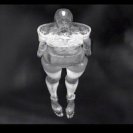Born in Sydney, Australia and currently residing in New York, interdisciplinary artist Justine Cooper’s artwork investigates the intersections between culture, science and medicine. She moves between many forms of media - animation, video, installation, photography, as well as medical imaging technologies such as MRI, DNA sequencing, Ultrasound and SEM (scanning electron microscopy). Her work has been internationally recognized and exhibited in over sixty shows and screenings including The New Museum of Contemporary Art, New York; The NTT InterCommunication Center, Tokyo; The Singapore Museum of Art; The Netherlands Institute for Media Art, The George Pompidou Centre, Paris; Kwang Ju Biennale, Korea, and the International Center of Photography, New York. She has participated in public panels on the theme of art and science and is one of the founders of WetLab (http://wetlab.org) a forum for the discussion of scientific ideas in the visual arts. She was the first artist-in-residence at The American Museum of Natural History. She has also been given residencies in Beijing, Santa Fe, Seattle, and the World Trade Center. Cooper’s artwork is held in public and private collections including the Metropolitan Museum of Art, The Powerhouse Museum (Sydney), The Queensland Art Gallery and the Australian Center for the Moving Image. Her work has been reviewed in The New York Times, ARTnews, ART Asia Pacific, NATURE and Art in America.
Justine Cooper’s Havidol [2007] were a series of spoof drug ads promoting a pharmaceutical treatment for the anxieties of everyday life. The fake ads were so close to genuine drug ads - and created in conjunction with equally convincing print ads and website [www.havidol.com] – that when first exhibited some viewers claimed to be suffering the fictitious debilitating disease – DSACDAD, or Dysphoric Social Attention Consumption Deficit Anxiety Disorder. The art direction of the videos are a convincing parody of stylings for pharmaceutical ads; male and female testimonials from poolside, a feel-good animation likening the ingestion and effects of the drug to springtime, and a family enjoying life with the aid of Havidol in a sunny suburban setting. Despite a contradictory list of stated side effects [“terminal smile”, “interspecies communication”] many were fooled.
Although on one level Cooper’s Havidol work could be taken for an ironic pastiche of contemporary advertising by pharmaceutical industries – and it is undeniably that - the subject of the work also relates to her interest in depicting the human body through the perspective of various medical and scientific technologies. Cooper’s work highlights the socially constructed nature of purportedly objective methodologies.
Cooper’s Rapt [1998] for example creates a poetic play of images using magnetic resonance image scans of her body. Spinning and zooming over imaged sections of her body the effect is akin to flying over a mysterious landscape. Reduction [2001] uses an infrared camera to document a performance piece. Rendered in ghostly black, white and greys, the snorting, sniffing and grimacing of the performers - somewhere between primates and zombies - gives the piece an unsettling anthropological air. Moist and Excitation [both 2002] use light microscopy, confocal microscopy and minimalist music accompaniment to create three dimensional landscapes from ultra-close-ups of blood, phlegm, cervical mucus and tears. S.O.S. [Sounds of Science] [2005] takes a tangential approach to similar conceptual territory. With the camera cruising up and down the halls of the American Museum of Natural History, the viewer notices that the hallways are lined with a seemingly endless procession of specimen cases, drawers and storage cupboards. While it is not clear what are in the cases, the soundtrack is made up of overlapping and cross fading animal calls and cries. Cooper’s suggestion is that, while the system may attempt to create an orderly taxonomy, the echo of lost life continues.
Selected solo/group exhibitions: The Leisure Class, Gallery of Modern Art, Queensland, 2007-08. Goodbye Privacy, Ars Electronica, Linz, Austria, 2007; Eye to I – The self in recent art, Ballarat Fine Art Gallery, 2007; The Art & Artifice of Science, The Museum of Fine Arts, Santa Fe, 2007; Mapping Bodies, 516 Arts, Albuquerque, New Mexico, 2007; HAVIDOL, Daneyal Mahmood Gallery, New York, 2007. National Academy of Sciences, Washington DC, 2006; Strange Attractors, Zendai MOMA, Shanghai, 2006; Asia-Pacific Triennial of Contemporary Art, Queensland Art Gallery, 2006-07; The Nature Machine, Queensland Art Gallery, 2005-06; Saved by Science, Mary Place Gallery, Sydney, 2005.
Selected publications: Art of Irony a bitter pill to swallow, The Sydney Morning Herald, November 3, 2007; Spoof drug exposes big pharma’s ‘disease mongering’, Lateline, ABC News, October 29, 2007; A lot of gall, Cabinet, Issue 25, spring 2007; The art and artifice of science, catalogue, Museum of Fine Arts Santa Fe, 2007; Designing a disease – and its drug, The Scientist, March 23, 2007 [www.thescientist.com]





